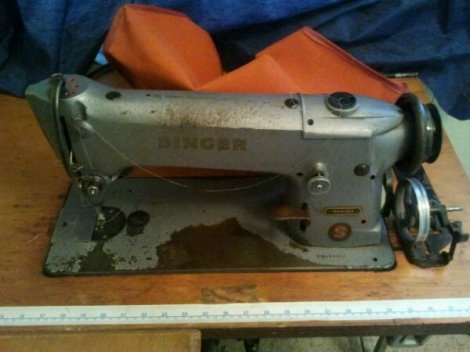When you aren’t used to one of these machines, they can be a little intimidating at first! 4,000 SPM (stiches per minute) at full throttle is a little scary, especially when you really like your fingers.
I picked this up via trademe for $160, petrol to go down and pick it up was only $40. Not too bad for a $200 outlay I thought. The motor has been replaced at some stage, and the drive belt is a little out of line as a result, but the belt stays on when rotating, and there is no slip under load.
I’ve got a couple of things up my sleeve to slow the machine down to a more ‘friendly’ speed. I will have to see if they work.
As it was fairly choked up with dust when I got it, I’ve cleaned it out as best I can, and given it a fairly good oiling. The tension bracket for the drive belt is missing, just need to get my act together and make a new one out of some threaded rod.

Can you tell me how to thread this belle?
It’s very similar to a ‘standard’ domestic machine. The major difference is that the thread is brought through, around and then back through the piece directly above the tensioning assembly. If detailed instructions with photos would help I can do that for you. 🙂
Hi there, I just got one of these from trade me also was only $40 + $30 for gas! but seriously in need of some tlc and the capacitor to run the motor just blew up yesterday. I would appreciate any help with further info like threading, cleaning, lubricating, instructions or owners manual. I cant seem to find much if any useful info on the net. and your right the speed at which this thing sews is a bit intimidating I took a step back when it was first cranked up!! thanks in advance 🙂
WHere can I get a drive belt
Hey, mine is running a non-standard drive motor, so my belt dimensions won’t help you, but there may be other sources.
Have a look in your local yellow pages for drive belt suppliers, often they will be able to supply/manufacture a belt with the correct profile and length. IIRC, you’ll need to have a rough measurement of the total length (using a piece of string) as well as taking a pulley in with you to get the correct profile. 🙂
Hope this helps.